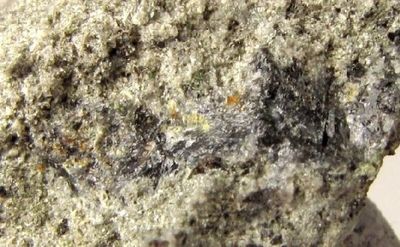Oosterboschit
| Oosterboschit | |
|---|---|
| Oosterboschit from the type locality , the Musonoi Mine near Kolwezi , Katanga , Democratic Republic of the Congo ( total size of the sample: 4.2 × 2.9 × 2.3 cm) | |
| General and classification | |
| other names |
IMA 1970-016 |
| chemical formula | (Pd, Cu) 7 Se 5 |
|
Mineral class (and possibly department) |
Sulfides and sulfosalts |
|
System no. to Strunz and to Dana |
2.BC.10 ( 8th edition : II / A.06) 02.16.15.02 |
| Crystallographic Data | |
| Crystal system | orthorhombic |
| Crystal class ; symbol | Please complete |
| Lattice parameters | a = 10.42 Å ; b = 10.60 Å; c = 14.43 Å |
| Formula units | Z = 8 |
| Twinning | polysynthetic |
| Physical Properties | |
| Mohs hardness | 4.5 to 5 (VHN 100 = 340) |
| Density (g / cm 3 ) | calculated: 8.48 |
| Cleavage | not defined |
| Break ; Tenacity | not defined |
| colour | silver-gray, on polished surfaces light yellow with a cream-colored tinge |
| Line color | black |
| transparency | opaque |
| shine | Metallic luster |
Oosterboschit is a very rarely occurring mineral from the mineral class of " sulfides and sulfosalts ". It crystallizes in the orthorhombic crystal system with the chemical composition (Pd, Cu) 7 Se 5 , so it is chemically a palladium - copper - selenide , whereby the two elements indicated in the round brackets can represent each other in the formula ( substitution , diadochy ), but always in the same proportion to the other components of the mineral.
Oosterboschite has so far only been found in the form of irregular grains about 0.4 millimeters in diameter. The mineral is opaque and silver-gray, metallic shiny color. On polished surfaces, the color appears rather light yellow with a tinge of cream.
Etymology and history
Was discovered Oosterboschit in about two kilometers from Kolwezi remote musonoi mine in the Democratic Republic of Congo belonging (Zaire) Katanga (formerly Shaba). The mineral was first described in 1970 by Z. Johan, P. Picot, R. Pierrot and T. Verbeek, who named it in honor of the Belgian mining engineer Robert Oosterbosch (* 1908). For many years, Oosterbosch has been committed to the development of mining in the Shaba / Katanga region.
The type material of the mineral is kept in the Mines ParisTech (also École des mines de Paris , English National School of Mines ) in Paris, France.
classification
In the now obsolete, but still common 8th edition of the mineral Strunz classification by belonged to the Oosterboschit to the Department of "alloys, and alloy-like compounds", where he together with Chrisstanleyit , Jagüéit , Luberoit , Tischendorfit and Vasilit the unnamed group II / A.06 formed .
The 9th edition of Strunz's mineral systematics , which has been in effect since 2001 and is used by the International Mineralogical Association (IMA), classifies the Oosterboschite under the category of “Metal sulfides with a substance ratio M: S> 1: 1 (mainly 2: 1)” . This is further subdivided according to the predominant metals in the compound, so that the mineral can be found in the sub-section "with rhodium (Rh), palladium (Pd), platinum (Pt) etc.", where it is the only one, depending on its composition Member forms the unnamed group 2.BC.10 .
The systematics of minerals according to Dana , which is mainly used in the English-speaking world , assigns the Oosterboschit to the class of "sulfides and sulfosalts" and there in the department of "sulfide minerals". Here it can be found together with rickardite in the unnamed group 02.16.15 within the subsection "Sulphides - including selenides and tellurides - with various formulas".
Education and Locations
Oosterboschit forms in the oxidation zones of different ore - deposits . Concomitant minerals include covellin , selenium-containing diginite , Chrisstanleyite , gold , trogtalite and Verbeekit .
As a very rare mineral formation, Oosterboschite is only known in a few samples from four sites so far (as of 2013). In addition to its type locality Musonoi, the mineral could only be found in the Democratic Republic of the Congo in the "Mutoshi" (Ruwe) copper mine, which is also located near Kolwezi .
Other previously known sites are the “Copper Hills” in the Pilbara region in Australia and the “New Rambler Mine” in Albany County (Wyoming) in the United States.
Crystal structure
Oosterboschite crystallizes orthorhombically, although the space group has not yet been determined. The lattice parameters are: a = 10.42 Å ; b = 10.60 Å and c = 14.43 Å and 8 formula units per unit cell .
literature
- Z. Johan, P. Picot, R. Pierrot, T. Verbeek: L'Oosterboschite (Pd, Cu) 7 Se 5 , une nouvelle espèce minérale, et la trogtalite cupro-palladifére de Musonoi (Katanga). In: Bulletin de la Société Française Minéralogie et de Cristallographie. Volume 93, 1970, p. 476.
- Friedrich Klockmann : Klockmann's textbook of mineralogy . Ed .: Paul Ramdohr , Hugo Strunz . 16th edition. Enke , Stuttgart 1978, ISBN 3-432-82986-8 , pp. 416 (first edition: 1891).
See also
Web links
Individual evidence
- ↑ a b c d Hugo Strunz , Ernest H. Nickel: Strunz Mineralogical Tables . 9th edition. E. Schweizerbart'sche Verlagbuchhandlung (Nägele and Obermiller), Stuttgart 2001, ISBN 3-510-65188-X , p. 71 .
- ↑ a b c d Oosterboschite. In: John W. Anthony, Richard A. Bideaux, Kenneth W. Bladh, Monte C. Nichols (Eds.): Handbook of Mineralogy, Mineralogical Society of America. 2001. ( PDF 60 kB )
- ↑ Stefan Weiß: The large Lapis mineral directory. All minerals from A - Z and their properties . 5th, completely reworked and supplemented edition. Weise, Munich 2008, ISBN 978-3-921656-70-9 .
- ↑ a b Mindat - Oosterboschite
